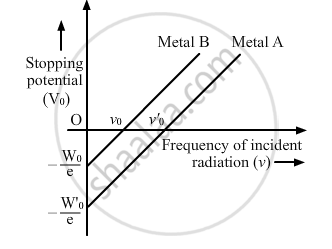Advertisements
Advertisements
प्रश्न
A photosensitive surface emits photoelectrons when red light falls on it. Will the surface emit photoelectrons when blue light is incident on it? Give reason.
उत्तर
The photoelectrons can be emitted from a metal surface if the frequency of incident radiation is more than the threshold frequency.
\[\text { Photemission took place when red light is incident on the photosensitive surface} . \]
\[\text { This means that }\]
\[\text { Work function of the surface } (W) < h \nu_{red} \]
\[\text { or }, W < \frac{hc}{\lambda_{red}} . . . . . (i)\]
\[\text { When blue colour light is incident on the surface, then energy imparted to electrons }\]
\[E = \frac{hc}{\lambda_{blue}} \]
\[As \lambda_{red} > \lambda_{blue} \]
\[\text { So,} \frac{hc}{\lambda_{blue}} > \frac{hc}{\lambda_{red}} . . . . . (ii)\]
\[\text { From equation (i) and (ii)}\]
\[\frac{hc}{\lambda_{blue}} > W\]
\[\text { So, photoelectrons will be emitted when blue light is incident on the photosensitive surface }. \]
APPEARS IN
संबंधित प्रश्न
Draw a neat labelled circuit diagram of experimental arrangement for study of photoelectric effect.
Light of intensity ‘I’ and frequency ‘v’ is incident on a photosensitive surface and causes photoelectric emission. What will be the effect on anode current when (i) the intensity of light is gradually increased. In each case, all other factors remain the same. Explain, giving justification in each case.
Two monochromatic beams, one red and the other blue, have the same intensity. In which case (i) the number of photons per unit area per second is larger, (ii) the maximum kinetic energy of the photoelectrons is more? Justify your answer.
The graph shows the variation of stopping potential with frequency of incident radiation for two photosensitive metals A and B. Which one of the two has higher value of work-function? Justify your answer.

The work functions for potassium and caesium are 2.25 eV and 2.14 eV respectively. Is the photoelectric effect possible for either of them if the incident wavelength is 5180 Å?
[Given : Planck’s constant = 6.63 x 10–34 J.s.;
Velocity of light = 3 x 108 m/s; 1 eV = 1.6 x 10–19 J]
Use Einstein's photoelectric equation to explain the observations from this graph ?
In photoelectric effect, why should the photoelectric current increase as the intensity of monochromatic radiation incident on a photosensitive surface is increased? Explain.
Draw a plot showing the variation of photoelectric current with collector plate potential for two different frequencies, v1 > v2, of incident radiation having the same intensity. In which case will the stopping potential be higher? Justify your answer.
Plot a labelled graph of IVsl where Vs is stopping potential versus frequency f of the incident radiation.
If the frequency of the incident radiation is increased from 4 × 1015 Hz to 8 × 1015 Hz, by how much will the stopping potential for a given photosensitive surface go up?
